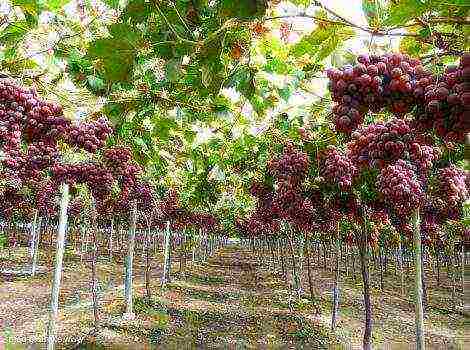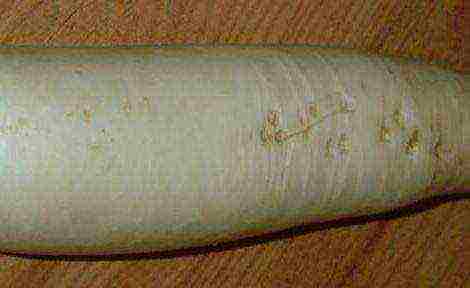Content
- 1 Repaired varieties - what is it
- 2 Repairing raspberries - growing and care
- 3 Pruning
- 4 Spring pruning
- 5 How to prune remontant raspberries
- 6 Polka
- 7 Polyana variety
- 8 Raspberry Hercules
- 9 Shugana
- 10 Indian Summer-2
- 11 Bryansk marvel
- 12 Diamond - a new variety
- 13 Bryansk jubilee
- 14 Monomakh's hat
- 15 Eurasia
- 16 Golden domes
- 17 Morning dew
- 18 Kalashnik
- 19 Apricot
- 20 Gardeners reviews
- 21 Apricot
- 22 Indian summer
- 23 Bryansk jubilee
- 24 Hercules
- 25 Eurasia
- 26 Yellow giant
- 27 Golden domes
- 28 Polka
- 29 Ruby necklace
- 30 Elegant
- 31 The best varieties of red early raspberries
- 32 What are the most productive varieties of late raspberries
- 33 The best new varieties of large-fruited remontant raspberries
- 34 What are the varieties of yellow raspberries
Today we will tell you about a group of raspberry varieties that have a unique ability to bear fruit even on annual shoots. We will present you the best remontant varieties of raspberries. You will learn how to care for them, prune them, and increase their yield.
Repaired varieties - what is it
If you look at the English-language publications on gardening, then this name means "continuously bearing fruit", "bearing fruit in the fall", "autumn-bearing fruit". In our reference books of gardeners for such varieties, the collective name "remontantny" was fixed.
It comes from the French "repair", which means to replenish, to repair. Gardeners in Europe, America and Russia admit that the best remontant raspberry has become an addition to the main assortment of fragrant berries.
Such varieties have been known for more than 200 years, but the older ones are distinguished by a small area of fruiting shoots in autumn. In the 18th - early 19th centuries, more than 20 varieties were described, and by the beginning of the 20th century, more than 60 of them were already known.
Repairing raspberries - growing and care
It is not difficult to care for raspberries of these varieties. Like all plants, it needs watering, loosening the soil, feeding and weed control. Seedlings of remontant raspberry love light and moisture. Their root system is located superficially, therefore, during the dry season, it needs regular watering. It should not be plentiful, since stagnant water can cause the death of small roots. The bush will not die, but it will take about ten days to restore the roots. At this time, the remontant raspberries will experience an acute nutritional deficiency. Growing and caring for it requires careful monitoring of moderate soil moisture.
When loosening the soil, try to be very careful not to damage the root system. From the center of the bush within a radius of a meter, the depth of loosening should not be more than 5 cm. To keep moisture in the upper layer longer, do not neglect mulching with peat or humus.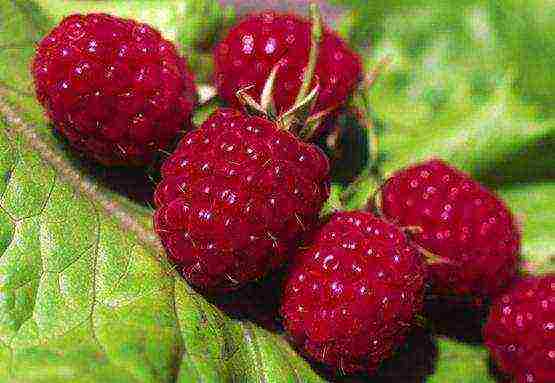
In the second or third year from the moment of planting, fertilizing with mineral fertilizers is required. At the beginning, immediately after planting, the remontant raspberry grows especially intensively. How to take care of her at this time? The plant should be "fed" with fertilizers containing nitrogen. In the middle of summer, it is necessary to use complex fertilizers containing phosphorus, nitrogen, potassium and trace elements. The gardener calculates the amount of fertilizer based on the instructions on the packages and the level of soil fertility on the site.
The best remontant varieties of raspberries in the middle zone of our country in early spring, after removing the snow, are covered with black film. Under such a "blanket" the sun's rays will warm up the soil much faster, therefore, the growing season will begin 2 weeks earlier than usual. Thanks to this, in the fall, the yield will increase by 500-600 g of berries from every 1 sq. meter of remontant raspberry.
Pruning
In Central Russia, annual shoots of remontant raspberries are cut at the very end of October. But don’t worry if you don’t have time to complete this work within the specified time frame, pruning can be done in early November. In the southern regions it is held until the end of November.
You should not be in a hurry with this work. It can be performed even when the topsoil is frozen. It is possible to carry out this work after the first snow falls. All this time, valuable nutrients are actively supplied from the shoots to the roots. This provides the plant with intensive development in the next season.
Spring pruning
In some regions, pruning is carried over into early spring. What is the difference between pruning raspberries in spring? For the repaired variety, such pruning is necessary in areas with warm winters. In these areas, after the completion of fruiting, the plant still vegetates for a long time and accumulates nutrients. If, after you cut the raspberry bushes in the fall, the soil does not freeze for 4 weeks, bud germination on the rhizome is possible. This will reduce next year's harvest.
Pruning raspberries in the spring (remontant in this case) is effective for areas with little snowy winters and a harsh climate. Shoots that have finished fruiting will contribute to snow retention. When the buds begin to bloom in the spring, pruning will help the plant receive growth substances that are synthesized in young leaves. The plant really needs them for the spring awakening. This is especially true in the northern regions, where summers are short and common varieties do not have time to ripen.
How to prune remontant raspberries
In the fall, when the entire crop has already been harvested, two-year-old shoots that actively bore fruit in the summer are removed at the root. Overgrown bushes are freed from unnecessary branches. In spring, the upper part of the branches (10-15 cm) is cut from the bushes. This procedure is carried out only once a year, due to which the raspberry tree is renewed and gives an excellent harvest.
Many novice gardeners are interested in which varieties of remontant raspberries are best. We will present you with the most common varieties. Perhaps this will allow you to make the right choice.
Polka
The best varieties of remontant raspberries tend to have large berries and higher yields. For example, the Polka variety, bred in Poland. Today it is the most popular variety in Europe. The main fruiting is given by the shoots of the current year. The plant bears fruit from early August until frost.
Shoots grow up to 1.6 m. They are dense, do not sag under the weight of the crop and do not need additional support. Polka gives about 100 shoots per 1 running meter.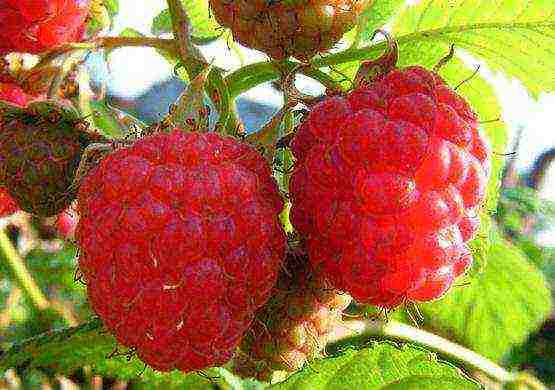
This is an excellent dessert variety that surpasses the Polyana variety in many ways. The berries are quite large, up to 10 g in weight, slightly elongated, dense, shiny, transportable, deep purple in color. They have a pleasant sour taste and a pronounced aroma. Productivity - more than four kilograms of berries from a bush.
Polyana variety
This is a standard remontant grade. He is originally from Poland. Fruiting from the second half of August until the first freezing temperatures, on annual shoots.
The bushes of this variety are powerful, undersized (do not exceed 120 cm). Shoots are erect, they do not need trellises. Shoots that appear in late spring can bear fruit in the same season. Berries of medium size, conical shape, shiny, firm, dessert taste, with a pronounced aroma. In late autumn, the taste deteriorates.
The yield reaches 6 kg per bush. This variety needs slightly acidic soils and good lighting. The first crop appears at the very end of June, the second at the beginning of August. Fruiting will continue until the onset of the first frost. In this case, the best remontant raspberries should be trimmed at ground level or completely mown.
Raspberry Hercules
This is a completely new large-fruited variety, characterized by upright, strong shoots. The first crop is harvested at the beginning of August. The bush is medium-sized, slightly spreading. Shoots of medium thickness, by autumn they turn purple, with a well-visible waxy bloom. The thorns are prickly and rigid, inclined downward, evenly distributed along the length of the branch.The plant has wrinkled, medium-sized, dark green leaves. The berries have an impressive size - up to 6 g, and have a sweet and sour taste. The yield of the variety is 2.5 kg from one bush.
Shugana
When gardeners discuss the best remontant varieties of raspberries, many of them call this one. The variety was bred in Switzerland. Differs in large berries of dessert taste and high yield. Bushes bear fruit from August to October, on the shoots of last year - from July. The yield of an adult plant can reach 9 kg per bush per season.
It is a strong, powerful plant. The bush does not require a garter. The berries are very large, shiny, bright red, conical in shape. On average, their weight is 10 g. After removing the berry from the bush, it remains in its original form for up to 4 days, without losing marketability.
Indian Summer-2
Another new standard remontant grade. It is successfully used in both industrial and home cultivation. It has strongly branching, upright, non-sticking shoots. The berries are not too large (3-3.5 g), pleasant taste, transportable. The variety is quite disease resistant. Differs in high yield (3 kg per bush). Most (80-85%) berries ripen in the first half of September. In the middle lane it gives 90% of the expected yield. Ripening begins in early August, strong shoots withstand the harvest well.
Bryansk marvel
A rapidly ripening remontant variety, with berries weighing 5-6 g. They have an elongated conical shape. They are characterized by excellent taste.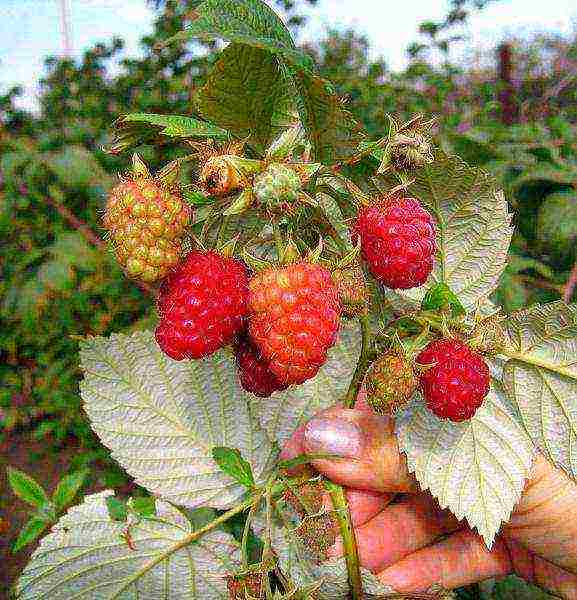
Fruits ripen in mid-August. Before the onset of the first frost, more than 70% of the fruits ripen. The berries do not fall or rot within 5 days. Surprisingly, the berries of this variety ripen, even if the branches have already been cut and placed in the water. This remontant variety is perfectly adapted to drought and heat. Productivity - 4.5 kg.
Diamond - a new variety
The best remontant varieties of raspberries, to which this new variety belongs, often require a garter. His bushes are very sprawling, low. They have 5-6 arched branching shoots.
The harvest begins in early August. Ripe berries remain on the bush for up to 7 days without decaying. Productivity - more than 2.5 kg. Berries of this variety are conical in shape, ruby color (up to 7.2 g). The surface is glossy, with a dessert flavor, but no aroma.
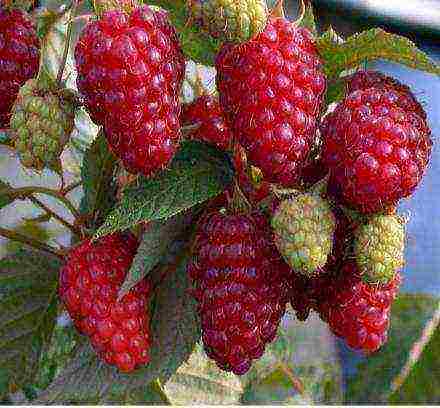
Bryansk jubilee
This plant grows up to 180 cm, slightly spreading bush. The berries are elongated, bright red, weighing up to 6 g. The taste is pleasant. Differs in high yield - 5 kg or more per bush. Begins to bear fruit from the end of July. On annual shoots, the berries ripen later.
Monomakh's hat
The bush looks like a small tree, up to 150 cm high. It has 3-4 powerful, highly branched, medium-drooping shoots. The thorns are mostly found at the bottom of the branch. The berries are large - the maximum weight is 10 g. Ripen in mid-August.
Eurasia
This variety is distinguished by large berries, early maturity. Ripening begins in early August. Berries do not rot on the branches for a long time. The yield exceeds 2.5 kg per bush. Raspberry Eurasia is resistant to pests and diseases.
Golden domes
Large-fruited remontant variety. The fruits have a characteristic golden apricot color of berries. The bush grows to a height of 150 cm. It is quite spreading, consisting of 5-6 drooping shoots. The berries ripen at the end of summer. The yield is more than two kilograms per bush. The fruits are large (6 g), with a rounded-conical shape. They are unusually colored - when overripe, the color changes to orange. The taste is sweet with a slightly acidic aftertaste.
Morning dew
A fairly "young" variety of remontant raspberries, bred in Poland. Young shoots grow up to 150 cm in height, tough, with thorns. The berries are large, golden yellow, bright, hard, tasty. The variety is poorly resistant to pests and diseases.
Kalashnik
Moscow remontant variety, which is used to get a rich autumn harvest.Kalashnik berries are dark red, blunt-conical, shiny, not very large (2-3 g). Sweet on the palate with a delicate "raspberry" aroma and extremely juicy pulp. They contain a small amount of seeds. Productivity is quite high - up to 3 kg per bush. Although, according to reviews of many gardeners, Kalashnik, with good care, can yield twice as much.
Ripens in early August. Between harvests, you can allow a break of 5-6 days, since the berries do not deteriorate on the bushes for a long time.
Kalashnik raspberry bushes grow up to 2.0 m in height. This is a powerful and spreading plant formed by 10-12 replacement shoots and 10 root suckers, which grow very quickly over the site. The shoots are thick, firm and firm. They are flowing, the upper part is fruiting, covered with a wax coating. The spikes are evenly spaced along the entire length. During the dormant period, they are colored brown.
Apricot
Great variety. During the ripening period, the bush is strewn with bright, large, orange with a golden tint, sweet berries (3.5 g). The plant is slightly spreading, about 150 cm high, shoots are slightly spiny. Its yield is more than 2 kg per bush.
Gardeners reviews
Many gardeners in our country are not very well known for remontant raspberries. The reviews of those who already have such a plant on their site are enthusiastic. Many people note the ease of caring for him. The high yield of such varieties and the size of the berries are striking.
Repaired raspberry varieties are gradually gaining popularity among domestic gardeners. They are distinguished by their unpretentiousness, high productivity and resistance to diseases. We have selected varieties that have held the title of the best of the best for several years.
One of the most popular garden berries is raspberry. In the CIS, preference is still given to traditional varieties, although, for example, in Europe, Canada and the United States, up to 90% of plantings are remontant varieties. Their main difference is that they begin to bear fruit in the first year and allow you to harvest a bountiful harvest twice a season - in summer and autumn. Since most of the remontant raspberries come from warmer countries, in the middle lane, before the onset of cold weather, the berry simply does not have time to fully ripen. Recently, however, Russian breeders have developed varieties with a short growing season especially for the northern regions. We managed to select the best varieties of both foreign and local origin.
Apricot
This is one of the most exotic varieties of raspberries. Although the bushes grow small, they nevertheless need a garter. The berries ripen on them are medium-sized and neat, yellow in color with a pinkish tinge, they are easily separated from the fruit. The shape of the raspberry is blunt-conical, the taste of the berries is reminiscent of apricot. The plant is practically resistant to diseases and pests. Connoisseurs especially recommend making jam of bright amber color from this raspberry.
| Appointment | Productivity (kg per bush) | Berry weight (g) | Bush height (m) | Maturation (period) | |
|
2,5-3,5 |
3-4 |
1,3-1,5 |
Early August - late October |
||
Indian summer
This is the first remontant raspberry variety bred in Russia. Designed for cultivation in the southern and central regions. The bush is sprawling, rather tall and erect. Berries of medium size, round-conical or spherical in shape. With the onset of ripeness, they acquire a dark crimson color. The taste is sweet and sour, but without a pronounced aroma. The pulp is tender and juicy, no frills. The variety is distinguished by winter hardiness, sometimes the plant is attacked by spider mites, powdery mildew disease and purple spot.
| Appointment | Productivity (kg per bush) | Berry weight (g) | Bush height (m) | Maturation (period) | |
|
1-2 |
3-4 |
1,8-2 |
Early June - early July. Early September - mid October |
||
Bryansk jubilee
A repaired early fruiting variety. The bushes are compact, with weak branching. The berries are not very large, beautifully elongated, bright red, sweet and sour.Under suitable conditions, fruiting begins in late July and then resumes in the fall. Productivity and, importantly, crop safety are at a high level. Disease resistance is average, the plant requires regular care, timely watering and feeding.
| Appointment | Productivity (kg per bush) | Berry weight (g) | Bush height (m) | Maturation (period) | |
|
2-3 |
3-4 |
1,2-1,4 |
Mid July - mid September |
||
Hercules
"Bryansk Bogatyr" is perfectly adapted to the climatic conditions of the middle zone. This variety is suitable for both domestic and industrial cultivation. The second wave of fruiting occurs closer to autumn, when the pests are no longer so active. Berries of intense ruby color with dense juicy pulp are similar to a truncated cone. Their taste is pleasant, sweet and sour. The variety is resistant to most fungal diseases, including gray mold. For the winter, it is advisable to cover the bush so that it does not freeze.
| Appointment | Productivity (kg per bush) | Berry weight (g) | Bush height (m) | Maturation (period) | |
|
2,5-3,5 |
5-7 |
1,5-2 |
Mid June. Mid August - early October |
||
Eurasia
A large-fruited variety, belongs to the standard varieties and at the same time is absolutely not picky about the composition of the soil and climate. An upright bush reaches a height of 1.5-1.6 m, so it is very convenient to pick berries from it. They are dark ruby in color, conical in shape, can be stored for a long time without loss of marketability. Raspberries taste sweet, but not sugary, but with a slight sourness and traditional raspberry aroma. The plant is quite resistant to all sorts of misfortunes, including temperature changes and pest activity.
| Appointment | Productivity (kg per bush) | Berry weight (g) | Bush height (m) | Maturation (period) | |
|
2-3 |
3,5-4,5 |
1,5-1,6 |
August - mid September |
||
Yellow giant
This type of raspberry is sometimes called the best variety for the middle lane. The bush has decorative properties, blooms very beautifully and bears fruit, so this raspberry in itself is a decoration of the garden. Neat yellow berries are useful for people with weakened immunity, allergy sufferers and pregnant women. They do not crumble from the bush for a long time and are perfectly stored. The plant has high frost resistance and is practically not afraid of various diseases.
| Appointment | Productivity (kg per bush) | Berry weight (g) | Bush height (m) | Maturation (period) | |
|
4-6 |
5-8 |
1,7-2 |
Mid July - mid October |
||
Golden domes
High-yielding variety of Russian selection. The bush is medium-sized, spreading, consists of 5-6 drooping shoots with small thorns. The berries are rather large, round-conical in shape and bright yellow in color, which later changes to apricot. The pulp is juicy, sweetish dessert, with an almost imperceptible raspberry aroma. The plant is resistant to the vast majority of diseases and is almost not attacked by pests. For the winter, it is advisable to leave only the rhizome, removing the entire aerial part.
| Appointment | Productivity (kg per bush) | Berry weight (g) | Bush height (m) | Maturation (period) | |
|
2-4 |
5-6 |
1,3-1,5 |
End of June - beginning of July. August - mid-October |
||
Polka
This is one of the most popular European varieties, the leader in yield among remontant raspberries. The bushes are practically devoid of thorns, so you can eat fresh raspberries without fear of scratching your hands. By the way, berries are the main advantage of this variety. They are beautiful, large, shaped like a thimble. The berries taste sweet, but not sugary; they are considered the standard of dessert taste. The plant is practically not susceptible to any type of disease. But what is contraindicated for bushes is heat and severe frost.
| Appointment | Productivity (kg per bush) | Berry weight (g) | Bush height (m) | Maturation (period) | |
|
2-3,5 |
5-6 |
1,5-1,8 |
End of July - beginning of October |
||
Ruby necklace
A high-yielding, transportable variety that is also suitable for industrial production. The bush is medium-sized, slightly spreading, with a small number of shoots.The berries are elongated, regular cylindrical, bright ruby color with a delicate sweet and sour pulp. At the end of fruiting, it is best to cut the aboveground part to ground level to avoid freezing of the plant.
| Appointment | Productivity (kg per bush) | Berry weight (g) | Bush height (m) | Maturation (period) | |
|
2-3 |
4-5 |
1,3-1,5 |
Mid August - mid October |
||
Elegant
This exquisite variety is appreciated by all lovers of a stable and abundant harvest. It is recommended for cultivation throughout Russia. A powerful bush is not prone to lodging, it grows no taller than human height. The berries are shiny, in the form of a wide obtuse cone, sometimes weighing up to 8 g. The taste is pleasant, the juicy pulp is sweet and sour. The plant practically does not get sick, the crop retains its presentation for a long time and is suitable for transportation over long distances.
| Appointment | Productivity (kg per bush) | Berry weight (g) | Bush height (m) | Maturation (period) | |
|
2,3-2,7 |
4-6 |
1,6-1,8 |
Early August - late September |
||
Repaired raspberry varieties are a real find for summer residents. These plants begin to bear fruit in the first year, require minimal care, are weakly susceptible to diseases and pests, and at the same time yield up to 2 times a year. Try to plant at least one bush of remontant raspberries and you will not be disappointed.
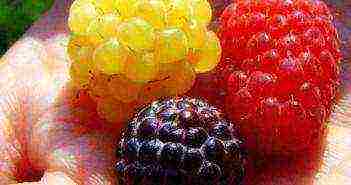
A juicy berry with an amazing taste, garden raspberries are a favorite crop for many gardeners. Plants do not differ in whimsical care, they multiply quickly and are able to give an excellent harvest even in small areas. All these advantages greatly facilitate its cultivation, especially since there are special remontant varieties of raspberries, which will be discussed in our article.
You can find out how the standard raspberry of the Tarusa variety looks like from this article.
What is she like
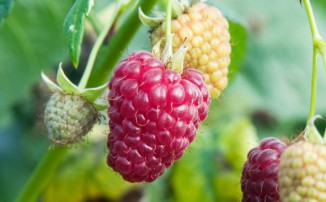
This amazing property distinguishes the varieties very favorably. The term "remontability" means the ability of raspberries to bear fruit already in the first year after planting. Such plants are also distinguished by a longer period of active fruiting, as well as the ability to harvest twice a season. As a rule, such hybrids begin to ripen earlier than usual, and after a short rest they bear fruit again, already closer to the end of summer - beginning of autumn.
Repaired raspberries differ in different ripening periods, so when buying it is better to focus on the climatic zone. Usually local nurseries offer varieties that are tailored to your specific conditions. If the purchase of raspberries is made remotely, it is necessary to carefully study the assortment and possible varieties. The optimal solution would be to select several varieties at once in order to subsequently determine the most successful species.
How raspberries are grown can be found in this article.
on the video, the best varieties of remontant raspberries:
Early ripe
The ripening period of their fruits is late July - early August. Fruiting lasts literally until the first frost, so these varieties are very profitable to grow in cold climates. Before buying, it is advisable to make sure that the plant tolerates a possible sharp cold snap and winter bad weather well.
Red raspberry care in the spring, as well as breeding features, are described in this article.
The best varieties of early raspberries:
- «Hercules"Is a highly productive variety with very large berries and a good degree of adaptability. The bush reaches a height of no more than two meters, while it does not differ in volumetric dimensions. There are few replacement shoots, but they are all strictly vertical, so the plant is easy to handle. The yield from one bush reaches 2.5 kilograms, which is a very good indicator. The great advantage of the variety is good transportability of berries and resistance to fungal diseases. According to the gastronomic assessment, the taste of the berries is very attractive and valuable.
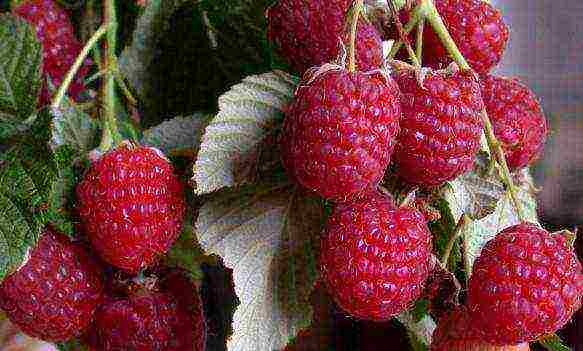
- «Bryansk marvel"- large berries on a relatively low (up to 1.5 meters) bush.At the same time, the fruiting zone occupies at least ⅔ of the length of the shoot. One bush gives up to three kilograms of excellent large berries per season. The average weight of fruits reaches 11 grams, length - up to four centimeters. They tolerate transportation well, therefore they are suitable for commercial breeding.
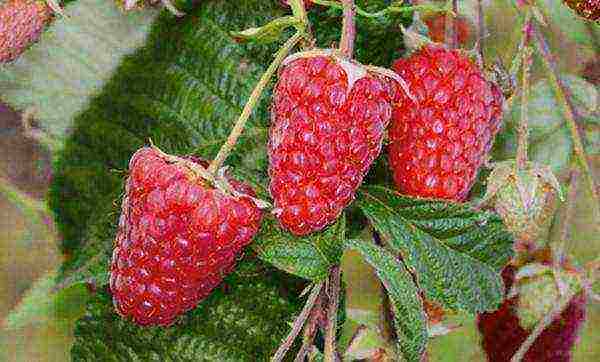
- «Brilliant"- large berries with a characteristic color and excellent taste. The productivity of one bush reaches 3 kg. ripe berries can remain on the bush for up to seven days without significant changes. This quality will allow you to grow raspberries in remote suburban areas, since there is no need to harvest daily.

- «Red Guard"- a relatively old variety, nevertheless it is still popular. First of all, this is due to the gigantic size of the berries and their taste characteristics. The bush itself forms shoots low up to 1.6 meters, half of which is occupied by the fruiting zone. The weight of one berry is on average 6 g, the yield is up to 3 kg per bush.

Mid-season
The harvesting period for such species begins in the second decade of August and also lasts until the first cold snaps. These features make the plant a suitable candidate for Central Russia. The yield, as a rule, of remontant varieties is very high, so the raspberry plant will have good productivity with minimal time and labor.
How does black raspberry look like planting and care, as well as the peculiarities of breeding this berry, are indicated in the article.
The best varieties of mid-season raspberries:
This article explains how to soak strawberry seeds before planting.
How strawberries are grown from seeds at home is indicated in this article.
What are the best varieties of remontant strawberries for Siberia are most often used, indicated in the article.
This article shows how strawberries are cultivated using the Dutch technology.
The most productive
Any gardener dreams of unprecedented harvests, which you can not only boast of among friends, but also receive tangible benefits and worthy reward for your efforts. Repaired raspberry varieties in one way or another are all high-yielding, but even among them there are real champions. Caring for such a plant is not too different from ordinary varieties, the main thing is to create suitable conditions and do not forget to harvest on time. Overripe berries on the branches are the worst indicator for a new harvest, the plant may even stop fruiting altogether.
What the Yellow Giant raspberry variety looks like is indicated in this article.
The best varieties of high-yielding remontant raspberries:
- «Brusvyan"- an early ripening variety, the average productivity of which reaches 8 kg per bush. The plant is a tree-like shrub that does not need a garter or props. The height of the raspberry reaches two meters, the weight of the berries is 15 grams. The flavor characteristics of the berries are at a high level and are highly appreciated.
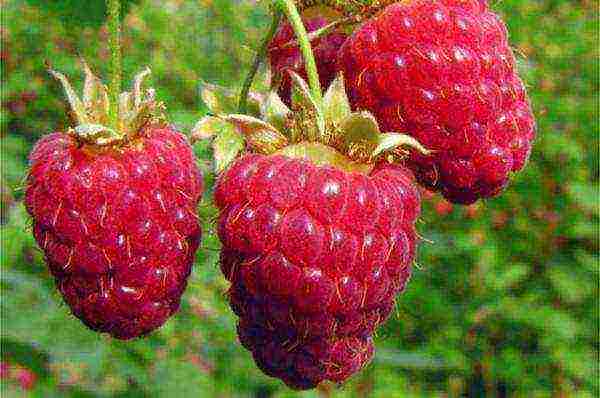
- «Yaroslavna"- yellow raspberry in its characteristics is the closest to the previous variety. High productivity and compact size (shoots up to one and a half meters high) make this species extremely popular.
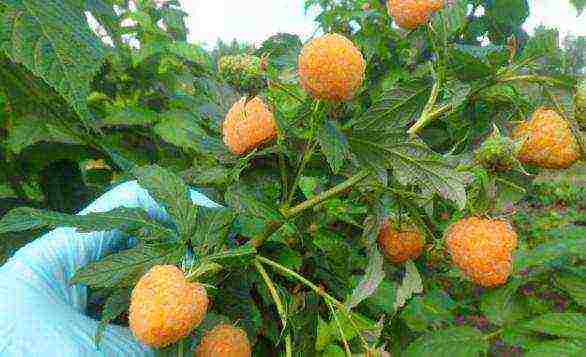
- «Polka"- a medium-sized bush with a large number of side shoots and a long fruiting period. Despite the fact that the variety is not one of the highest-yielding varieties, but due to the high quality of the fruits and the ability to trouble-free transportation, this species is rightfully considered the standard among the like. The yield from one bush reaches 3.5 kg, the weight of berries is up to 10 g.
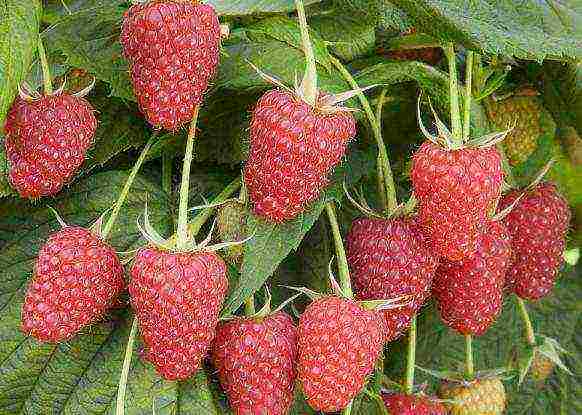
- «Penguin"- a relatively small standard bush, reaching a height of only 1.3 meters, but extremely fertile. With proper care, the yield from one bush can reach 15 kg.
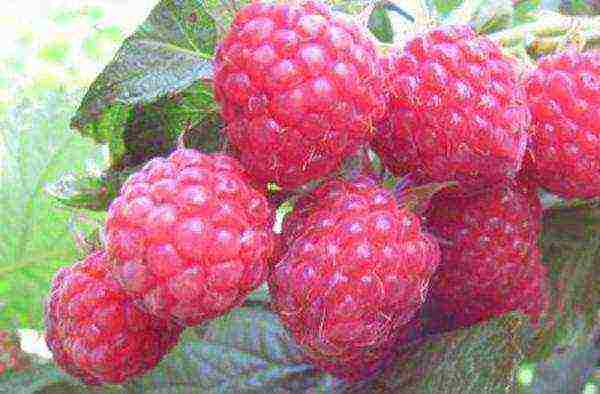
- «Shugana»A relatively new variety originally from Switzerland. Average yield indicators reach 9 kg. The berries are very large in size and have excellent taste.
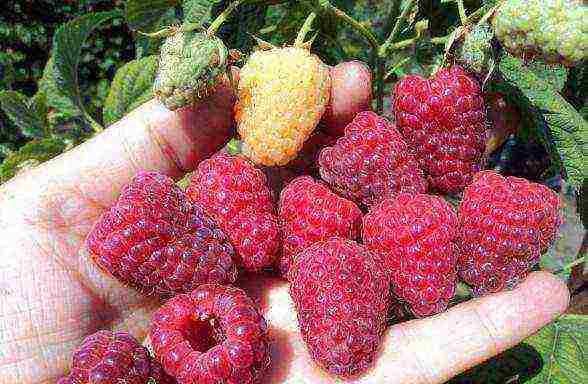
- «Apricot»Despite the relatively small size of the berries, it is highly fertile and loved by many generations of summer residents. The average weight of the berries is 3.5 - 4.2 g, but a small bush is almost completely covered with them. Harvested until mid-October, the berries are extremely tasty and aromatic. All this makes this variety an absolute favorite among similar species.
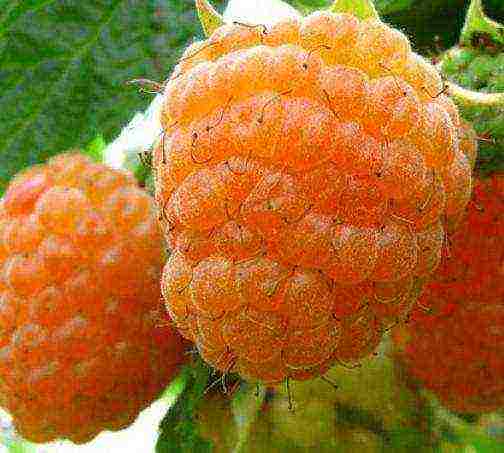
- «Yellow giant"- a real record holder among the varieties of yellow raspberries. The berries are unusually large and can reach 12 grams. Excellent taste and productivity of the bush (up to 12 - 15 kg per season) make this variety one of the best in its category.
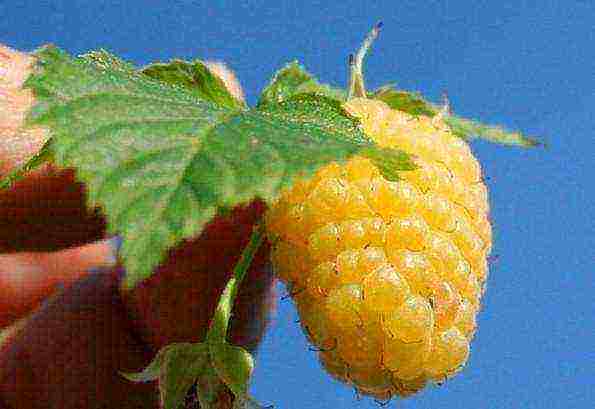
Choosing the right raspberry variety for your site is an extremely responsible and important business. Before buying, you need to correctly prioritize tasks and decide on the purpose of the harvest. Usually, remontant varieties that bear fruit until the very frost are considered the most productive and profitable in breeding. The use of such varieties does not require special conditions of detention, while the varieties are quite unpretentious and high-yielding. A brief overview of the best varieties of remontant raspberries is presented in our article.
Among them, gardeners can choose the best to their taste: early or late, high-yielding or remontant, with red, yellow and even black berries. Find out which raspberry varieties are the most popular in hobby gardening.
The best varieties of red early raspberries
"Balm". Slightly spreading bush, medium height, medium shoot-forming ability. The berries of this early raspberry variety are conical, dark raspberry with slight pubescence, sweet and sour taste with aroma.
"Modest". The bush is medium, slightly spreading. Berries are hemispherical, dark raspberry color, sweet and sour taste, no aroma.
"Companion". The bush is erect, high. The berries of this are one of the earliest varieties of hemispherical raspberries, dark raspberry color, sweet and sour taste.
"Crane". Variety of medium early ripening, remontant. Slightly spreading bush, erect, powerful shoots. Berries are large, conical, raspberry, sweet and sour taste with aroma.
"Hussar". The bush is tall, powerful, does not need support, there is little overgrowth. This is one of the best early raspberries with elongated ruby red berries, sweet and sour taste and amazing aroma.
"Sun". The berries are large, round-conical, crimson in color with delicate fragrant pulp.
"Patricia" - the most interesting among large-fruited raspberry varieties with attractive, beautiful berries. The berries are large, individual up to 14 g, truncated-conical in shape, with a beautiful velvety surface, of medium density, they are removed from the fruit plant without breaking, when fully ripe they do not crumble for a long time. The taste of berries is sweet with a pleasant "raspberry" aroma, juicy melting pulp and a few small seeds. Productivity of 4-5 kg per bush. Fruiting annually, early ripening variety. One of the most productive varieties. Plants are medium-sized (up to 1.8 m), non-repaired, semi-sprawling, annually form 6-10 replacement shoots and 5-7 root suckers.
"Maroseyka" - the first domestic thornless variety with very large berries (up to 12 g) and high yield (4-5 kg per bush). Some of the red berries of this raspberry variety are double, conical. The taste of berries is sweet with a pleasant aroma. Fruiting annually, medium-early ripening variety. Bushes about 1.5 m tall, spreading, powerfully developed, not repaired.
"Aboriginal" - an early variety for areas of the non-chernozem zone. Differs in a high yield, large (4-8 g) bright red berries. The berries are conical, well-formed, easily removed from the fruit-bearing.
What are the most productive varieties of late raspberries
Below it is described which varieties of late raspberries are the most productive, and therefore are the most popular.
"Brigantine". Berries are dark raspberry, dense, round-conical, good taste.
"Tarusa" - the first domestic variety with standard-type shoots, strongly thickened, hard and tough. Bushes practically do not require supports, but still the harvest is better obtained with a trellis. The berries of this fruitful variety of raspberries are large (up to 12 g), blunt-conical, bright red in color, shiny, well removed from the fruit-bearing. The berry taste is sweet with a pleasant raspberry aroma. Productivity of 3-4 kg per bush. The bushes of this variety are of medium height (about 1.5 m), compressed type, powerfully developed, non-repairable, form 8-10 replacement shoots and 4-5 root suckers each, do not creep over the site.
"Arbat" - among the new large-fruited varieties of raspberries, it stands out for the abundance of very large berries with a mass of 15-18 g and more. The berries are elongated and conical, dark red in color, shiny, removed from the fruit plant without breaking. The taste of berries is sweet with a pleasant raspberry aroma, juicy melting pulp. Productivity - up to 9 kg per bush. Plants of this one of the most productive varieties of raspberries are medium-sized (1.5-2, Ohm in height), spreading, powerfully developed, non-repairable.
"Hercules". This variety of raspberries has a medium-sized and slightly spreading bush, shoots are strong, upright, you can do without trellises when growing. Annual shoots are green in spring, and by autumn they acquire a purple hue with a waxy bloom. The thorns are hard, thin and prickly. Autumn harvest in the middle lane reaches 1.5 kg per bush. The first fruits appear on the bushes in early August. Fruiting lasts until the first frost. The fruits of this variety are very large, the average weight of one berry is 5 g, the maximum reaches 10 g. The berries have a truncated-conical shape. The color of the berry is ruby, the taste is sweet and sour.
"Daughter of Hercules". A high-yielding variety with very large tasty berries, weighing 8-10 g. Some berries reach a weight of 20 g.
As you can see in the photo, this ort of raspberries has berries of an elongated-blunt-conical shape, dense, well-transportable:
The bush is medium-sized, the shoots are highly branched. Requires little support.
"Firebird". Large-fruited, high-yielding variety with bright red berries. A distinctive feature is high drought resistance and heat resistance.
"Calendar". This variety is sometimes called the "raspberry tree" for its powerful shoots and bush as a whole. Do not creep over the site. Recommended for growing in all horticultural zones of the European part of Russia.
"Beauty of Russia". It bears fruit with a very tasty berry and has a medium-early ripening period. Berry weighing up to 12 g. This one of the best varieties of raspberries has a smooth trunk and bears fruit well in a sunny area, does not like thickening. Highly productive with good care. These berries can not only be eaten from the bush, they can be admired.
"Stolichnaya" - a late variety of raspberries, high-yielding, distinguished by powerful shoots without thorns. The berries are large (4-8 g), homogeneous, well removed from the fruit plant. When ripe, 3-4 days do not crumble.
The best new varieties of large-fruited remontant raspberries
Here you can find photos and descriptions of remontant type raspberry varieties.
"Indian summer". The first domestic cultivar of remontant raspberry with predominant fruiting on annual shoots.
"Apricot". Amber fruits with a pink blush have an apricot flavor. Such amazing berries delight not only children, but also seasoned adults. This raspberry begins to ripen in August and bears fruit until frost. During the summer-autumn period of fruiting, gardeners manage to collect up to 4 kg of berries. Semi-spreading bushes, medium height. Thorns are located mainly in the lower part of the shoots, so they do not interfere with caring for the plant and harvesting at all.
"Bryansk Marvel". The variety of this raspberry has a medium-sized and compact bush, which reaches a height of 1.6 m. Fruiting is abundant, fruits are large, up to 6 g. The berries have a graceful elongated-conical shape with a pleasant taste and delicate aroma. They separate well from the stalk. Up to 5 kg of raspberries are harvested from the bush.The first crop is harvested in July, and the second - from mid-August until the first frost.
"Taganka" - early variety, high-yielding, large-fruited. Numerous thorns on the shoots. The berries are large (4-8 g), conical. The grade is remontant. The berries of the autumn harvest are also very large (up to 6 g).
"Kalashnik" - a remontant variety, which is used exclusively for obtaining an autumn harvest.
"Pride of Russia". This one of the best remontant raspberries is distinguished by its large and attractive berries. Weight reaches 12 g, individual berries can reach 18 g. Fruits have a conical and blunt-conical shape with a velvety surface. The berries are easily removed from the stalk and, when fully ripe, do not crumble.
The taste is sweet, light and pleasant aroma. The berries are juicy and have small seeds. Up to 5 kg of fruits are harvested from each bush. Bears fruit every year. The variety ripens on July 8-10, therefore it is considered medium early. The bush of this variety is medium-sized and compact. The variety is not remontant.
"Cap of Monomakh". A remontant variety, it has a low bush in the form of a small tree, which forms several slightly drooping, highly branched shoots. The variety is distinguished by large fruits (up to 7 g) of ruby color, elongated blunt-conical shape. The berries come off well from the stalk, ripen in mid-August and bear fruit for a long time. You can collect 5.5 kg of berries from a bush. However, not all berries have time to ripen before the first frost begins. The first crop is harvested in July, the second from mid-August until the first frost.
"Giant" considered one of the best varieties for cultivation in summer cottages. This is a new variety of raspberries that has a distinctive feature: it lacks thorns. The weight of the fruits of this one of the best varieties of large-fruited raspberries can be 25 g. The yield of one bush reaches 12 kg, of course, subject to all the rules of agricultural technology.
Atlant - one of the best varieties of remontant raspberries with very tasty and aromatic berries. Moreover, even cold and rainy weather does not negatively affect the taste of the berries. The first berries ripen in mid-August, and then the yield goes very quickly. By mid-September, up to 5 kg of fruit can be harvested from one bush with good care.
"August miracle" - remontant raspberry variety forms a low compact bush, consisting of 7-8 upright shoots. The berries are formed almost along the entire length of the shoot, large, weighing up to 4 g, excellent taste with a delicate aroma. High productivity - 4 kg per bush.
"Penguin". The variety got its name for the standard type of bush. Strong shoots with shortened internodes, does not require additional support (bush height 1.1-1.4 m). The variety is remontant, fruitful, one of the earliest ripening, until mid-September the harvest has time to ripen completely. The berries are large, 6-8 g, round-conical, dark crimson. After ripening, they can hang on the bush for 5-6 days without decaying.
"Eurasia". A variety with a ripening period in the first decade of August. Large berries with good taste. Raspberry-like fruiting of medium vigor.
What are the varieties of yellow raspberries
"Orange miracle". This remontant variety has large berries (10-12 g) of golden yellow color and elongated conical shape. The bush reaches a height of 1.6 meters. The thorns are soft and short. The bush of this yellow raspberry variety does not need support. The variety is high-yielding, which is usually not characteristic of yellow-fruited varieties.
"Golden autumn". Large-fruited, remontant variety with bright golden yellow berries. The berries are large, 5-7 g, individual up to 11 g, beautiful, elongated-conical, dense. Dessert-flavored berries with a persistent raspberry aroma. The yield is high. Resistant to diseases and pests.
"Yellow Miracle". Exceptionally productive remont variety, with large (6-8 g) yellow berries, Good dessert taste. The variety is vigorous, the shoots are thick and strong, but requires support.Differs in late onset of autumn fruiting (first decade of September). It is best used as a variety that combines summer and autumn harvests.
"Yellow giant" considered the largest among all raspberry varieties. The sweet fruit reaches the size of a walnut. The bushes grow crowded, up to 2.5 m in height. In the fall, the upper part of each shoot is cut off at a height of two meters. With this technique, you can achieve the formation of larger fruits. The shoots are strengthened on a trellis.
Now watch the video "Raspberry Varieties" to get a better idea of what shrubs and berries look like:
